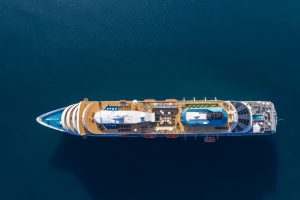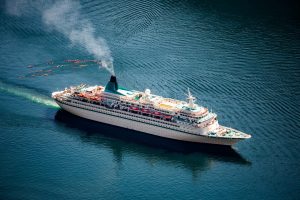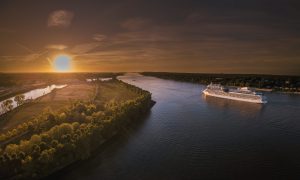
Cruise ships are big. Even the “small” ones are big. But how big? What’s the length of a cruise ship? And why do they have to be so big?
Let’s answer that last question first: They don’t have to be big, especially when plying the waters of rivers rather than oceans. But ocean liners do tend to be big for a couple of reasons.
First, cruise ships are big because the ocean is big. Trans-oceanic travel requires massive ships because the distances they travel are vast and the number of passengers and crew they carry is high. With all those nautical miles to travel and all those people to ferry, ships need to be floating, self-sustaining communities for however long they plan to be at sea.
The second reason is related to the first: Ship owners and operators want as many people on board as possible doing as many fun things as possible. That means massive vessels that can carry travelers and crew while providing room onboard for a wide range of enticing amenities: theaters, fitness centers, swimming pools, casinos, nightclubs, restaurants — even entire amusement parks!
Ships Big and Small
When it comes to the length of a cruise ship, there is no standard answer. But the difference in size has a significant impact on the overall experience of the cruise, as well as the destinations and activities available onboard. Furthermore, smaller ships tend to be more eco-friendly and less harmful to the seabed.
The world’s biggest cruise ship as measured by internal volume — aka gross tonnage (GT) — is Royal Caribbean’s Wonder of the Seas. It can carry more than 7,000 passengers (fewer at double occupancy) and 2,200-plus crew members at full capacity. That’s a larger population than many cities!
How big is the Wonder of the Seas? It’s about 1,200 feet in length. Actually, though, it’s the ship’s height that seems truly astonishing, especially when it’s docked and you crane your neck to look up at its 18 towering decks.
Standing atop or next to the largest cruise ships in the world — cruise lines that are floating cities in many respects — is a powerful experience.
By comparison, the American Star, which USA River Cruises utilizes for its New England Islands, Chesapeake Bay, and other cruises, has just a 100-passenger capacity. It’s about 215 feet long.
The Safari Voyager, on the other hand, holds 62 guests and is 174 feet long — the perfect cruise ship length for its Baja’s Bounty excursions.
Cruise Ship Length
So to finally get to the main question posed above: How long is a cruise ship?
It depends!
 While ocean-going vessels are often massive, river cruise ships are much more compact, with many designed to fit through narrow locks and under low bridges. This allows for a more intimate cruising experience, with less crowding and a greater sense of community onboard.
While ocean-going vessels are often massive, river cruise ships are much more compact, with many designed to fit through narrow locks and under low bridges. This allows for a more intimate cruising experience, with less crowding and a greater sense of community onboard.
However, this also means that some amenities commonly found on large ocean liners must be left off of river cruises, such as rock climbing walls, large pools, and full-size theaters.
Another key difference between river and ocean cruises is the types of destinations available.
While ocean liners can travel great distances between ports, river cruises are limited to the rivers they traverse. This often means that river cruises feature more localized itineraries, with stops at small towns and culturally significant sites along the way.
For example, a river cruise down the Rhine might include stops in quaint German villages with medieval castles, while an ocean cruise might offer a more sweeping tour of the Mediterranean.
Understanding the Length of a Cruise Ship
Differences between River and Ocean Cruises
Cruises have long been popular vacation options for people all over the world, offering a blend of adventure, luxury, and relaxation. While there are several types of cruises available, the size of the ship can make a significant difference, especially when it comes to river cruises.
 We posed and answered questions regarding the length of a cruise ship above, but obviously, that answer is far from comprehensive. And how could it be? Cruise ship lengths vary a great deal.
We posed and answered questions regarding the length of a cruise ship above, but obviously, that answer is far from comprehensive. And how could it be? Cruise ship lengths vary a great deal.
What really matters is the type of cruise experience you’re interested in having. With that information in hand, your cruise planner can set things up for you. At that point, the only reason to consider the length of a cruise ship is to help determine the right trip for you and your family.
However, since many first-time cruisers often wonder how long a cruise ship is and how it impacts their travel experience, we thought it would be fun to explore the topic a bit.
In the rest of this piece, we’ll dive into the differences between river and ocean-going cruise ships, how the size impacts the travel experience, and the destinations you can explore with USA River Cruises.
Cruise Ship Lengths: River and Ocean Trip Overview
Let’s recap our newfound understanding of the length of a cruise ship, including a few more comparisons.
While there is no standard length for a cruise ship, ocean-going ships are typically larger than river cruise ships.
For instance, an average ocean cruise ship is about 1,000 feet long and 200 feet wide. In contrast, the river cruise ships are much smaller, ranging in length from 110 feet to 600 feet and only 40 to 50 feet wide. The smaller size of river cruise ships limits onboard amenities that can be offered.
When comparing river cruises with ocean cruises, it’s worth noting that river cruises have a special charm that ocean cruises cannot match. River cruises are known for offering a more intimate experience since the ships are smaller and can offer more personalized experiences.
River cruises often prioritize more intimate dining experiences, too, along with cultural activities and lectures on local history and culture.
The size of the vessel also makes it easier to dock closer to town centers, which means passengers have a better opportunity to explore their destinations. An ocean-going vessel doesn’t always have the same level of flexibility for docking, and passengers often need to take a shuttle or taxi to explore the area.
Smaller vessels are able to visit smaller towns and villages. Large cruise ships typically take passengers to major ports, but with smaller ships, travelers can experience more of the local culture of small towns.
About those Amenities
Another significant difference when it comes to the size of the ship is the onboard amenities. Larger ocean ships offer more onboard facilities and activities, including restaurants, bars, theaters, shopping centers, swimming pools, and fitness centers.
Smaller ships may lack many of these amenities and offer a more minimalistic approach. For example, river cruises are limited in making use of small spaces while still providing a relaxing and comfortable environment. It’s a bit like comparing hotels; smaller ships offer more of a “boutique hotel” experience, while big ships offer more of a resort chain experience.
Length of Trip
The size of the vessel also impacts the travel experience and the destinations you can explore. As ocean liners are more substantial, they can cover vast distances, and so they tend to have longer itineraries and offer a broader range of destinations.
In contrast, some river cruises have limitations imposed upon them by river lengths, depths, and the existence of locks, dams, and associated width restrictions. As a result, some river cruises tend to have shorter itineraries with fewer ports of call.
But that’s not always the case; some of our cruises include many days and nights of cruising time. A few of the more popular river cruises include the Journey on the Columbia and Snake Rivers (7 days/6 nights), the Music Cities Cruise (8 days/7 nights), and the Northwest Pioneers cruise along the mighty Columbia River (11 days/10 nights).
What’s more, many river cruises include land tours in their itineraries for a unique experience — and an extended vacation. For example, consider our Maine Coast Explorer package.
Experiences
It’s also worth noting that the length of the ship can have an impact on the overall travel experience as it relates to personal comfort levels.
 For example, some travelers insist that larger ships are more stable and smoother sailing, with fewer effects from waves and weather. In contrast, they say, smaller river cruise ships may be more susceptible to choppy waters, particularly in narrow canals or in the midst of storms.
For example, some travelers insist that larger ships are more stable and smoother sailing, with fewer effects from waves and weather. In contrast, they say, smaller river cruise ships may be more susceptible to choppy waters, particularly in narrow canals or in the midst of storms.
But just as many passengers will tell you that smaller river ships tend to offer a smoother ride, while larger ocean ships may experience more movement due to their size and weight! For example, the upper and lower Mississippi River cruises are so gently flowing that many passengers rarely feel the water at all!
Finally, larger ships may be subject to long lines and wait times, particularly when embarking and disembarking and when waiting for your time to participate in the more popular onboard attractions.
Pricing
One last thing worth mentioning: The size of the vessel and the onboard amenities will impact the cruise price.
River cruises may appear more expensive for the smaller size, but this is primarily because they offer a range of exclusive experiences that are hard to find on bigger ships.
In contrast, ocean cruises tend to offer a broader range of activities, amenities, and services, and this is often reflected in the cruise cost.
When it comes to accommodations, both river and ocean cruising offer a range of options.
The length of a cruise ship plays a crucial role in determining the ship’s travel experience, destinations, and onboard amenities, as well. Large cruise ships offer plenty of options, while a smaller ship may offer passengers a more intimate experience, where guests can have a closer connection to the scenery and the local culture.
To sum it all up: River cruise ships are much smaller than their ocean-going counterparts, offering a more personal and intimate experience. River cruises are generally more focused on the destination and sightseeing rather than the onboard experience. Ocean-going vessels are packed with activities, amenities, and various forms of entertainment.
Going on a cruise is one of the most exciting travel experiences you can have. The tranquility of the water, the plethora of onboard activities, and the breathtaking destinations all combine to create a memorable vacation.


